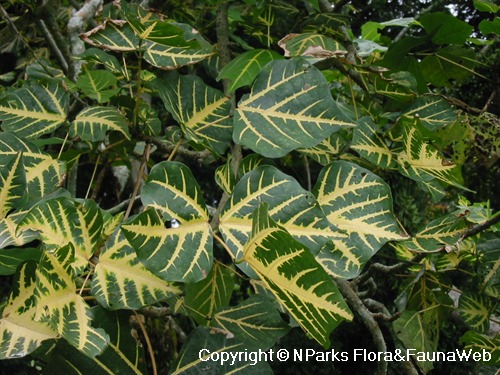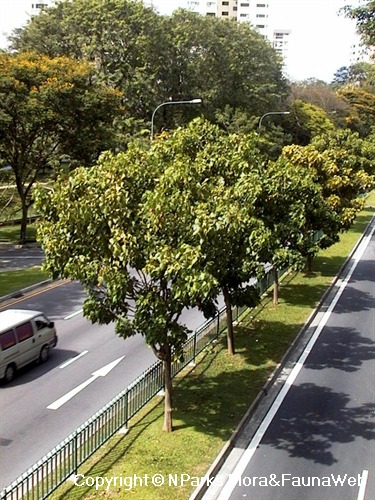.jpg)
Back
Erythrina variegata L.
| Family Name: | Fabaceae (Leguminosae) |
| Synonyms: | Erythrina indica var. alba Blatt. & Millard, Erythrina indica Lam. |
| Common Name: | Variegated Coral Tree, Dedap, Derdap, Mountain Ebony, Indian Coral-Tree, Tiger's Claw, Variegated Tiger's Claw, Dedap Batik, Chengkering, Cockspur, Dadap, Coral Tree, 刺桐 |
Name
Classifications and Characteristics
| Plant Division | Angiosperms (Flowering Seed Plants) |
|---|---|
| Plant Growth Form | Tree |
| Lifespan (in Singapore) | Perennial |
| Mode of Nutrition | Autotrophic |
| Maximum Height | 27 m |
Biogeography
| Native Distribution | Eastern Africa, the Indian Ocean Islands, Southeast Asia, the Pacific Islands |
|---|---|
| Native Habitat | Terrestrial |
| Local Conservation Status | Non-native |
Description and Ethnobotany
| Growth Form | Large tree, able to grow up to about 27 m in its natural habitat. |
|---|---|
| Trunk | Bark surface has grooves. |
| Foliage | Compound leaves with light green and yellow variegation, each leave has 3 ovate leaflets about 4 - 25 cm long and 5 - 30 cm wide, terminal leaflet is the largest. |
| Flowers | Red flowers usually in groups of 3 borne on an axillary raceme inflorescence about 10 - 40 cm long. |
| Fruit | Fruit is a long cylindrical pod about 10 - 45 cm long and contains up to 13 black or purple seeds. |
| Habitat | Can be found in coastal forests. |
| Etymology | Genus Erythrina is from the Greek word "erythros" which means "red" and refers to the flowers. Species variegata means irregularly coloured and refers to the leaves. |
| Ethnobotanical Uses | Medicinal: The bark is used to treat fever in Myanmar; liver problems in China; dysentery in Indonesia; and intermittent fever in Indochina. The bark has also been used to treat rheumatism, as a painkiller in toothache and to promote the expulsion of phlegm from the respiratory passages. The leaves are used in Malaysia to improve appetite, to promote sleep, to control fever as well as to remove phlegm, among other uses. |
Landscaping Features
| Desirable Plant Features | Ornamental Flowers, Ornamental Foliage |
|---|---|
| Landscape Uses | Parks & Gardens |
| Usage Hazard - Cons | Spines/Thorns - Stem/Branch |
Plant Care and Propagation
| Light Preference | Full Sun |
|---|---|
| Water Preference | Moderate Water |
| Plant Growth Rate | Moderate |
| Rootzone Tolerance | Moist Soils, Well-Drained Soils |
| Propagation Method | Seed |
Foliar
| Mature Foliage Colour(s) | Green, Yellow / Golden |
|---|---|
| Foliar Type | Compound (Trifoliate) |
| Foliar Attachment to Stem | Petiolate |
Floral (Angiosperm)
| Flower Colour(s) | Red |
|---|---|
| Flower Grouping | Cluster / Inflorescence |
| Flower Location | Terminal |
Fruit, Seed and Spore
| Fruit Classification | Simple Fruit |
|---|---|
| Mature Seed Colour(s) | Red |
Image Repository
Others
| Master ID | 31227 |
|---|---|
| Species ID | 5622 |
| Flora Disclaimer | The information in this website has been compiled from reliable sources, such as reference works on medicinal plants. It is not a substitute for medical advice or treatment and NParks does not purport to provide any medical advice. Readers should always consult his/her physician before using or consuming a plant for medicinal purposes. |

.jpg)
.jpg)



.jpg)
